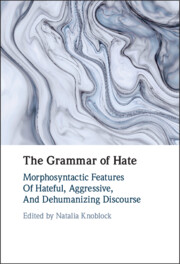Book contents
- The Grammar of Hate
- The Grammar of Hate
- Copyright page
- Contents
- Figures
- Tables
- Contributors
- Acknowledgments
- Introduction
- 1 Animacy and Countability of Slurs
- 2 Language Aggression in English Slang: The Case of the -o Suffix
- 3 Adj+ie/y Nominalizations in Contemporary English
- 4 Grammatical Gender and Offensiveness in Modern Greek Slang Vocabulary
- 5 Unseen Gender
- 6 The Neutering Neuter
- 7 Neutering Unpopular Politicians
- 8 The Power of a Pronoun
- 9 Is Play on Words Fair Play or Dirty Play?
- 10 Expressive German Adjective and Noun Compounds in Aggressive Discourse
- 11 ‘Kill the Invaders’
- 12 ‘I am no racist but …’
- 13 Homophobic Space–Times
- Index
- References
6 - The Neutering Neuter
The Discursive Use of German Grammatical Gender in Dehumanization
Published online by Cambridge University Press: 30 June 2022
- The Grammar of Hate
- The Grammar of Hate
- Copyright page
- Contents
- Figures
- Tables
- Contributors
- Acknowledgments
- Introduction
- 1 Animacy and Countability of Slurs
- 2 Language Aggression in English Slang: The Case of the -o Suffix
- 3 Adj+ie/y Nominalizations in Contemporary English
- 4 Grammatical Gender and Offensiveness in Modern Greek Slang Vocabulary
- 5 Unseen Gender
- 6 The Neutering Neuter
- 7 Neutering Unpopular Politicians
- 8 The Power of a Pronoun
- 9 Is Play on Words Fair Play or Dirty Play?
- 10 Expressive German Adjective and Noun Compounds in Aggressive Discourse
- 11 ‘Kill the Invaders’
- 12 ‘I am no racist but …’
- 13 Homophobic Space–Times
- Index
- References
Summary
Grammatical gender in German has traditionally been described as a rather arbitrary system. This is not the case in regard to terms of person reference, where natural gender assignment is the norm: masculine and feminine grammatical gender largely correlate with the extralinguistic assignment of male and female gender. Neuter gender predominantly denotes inanimate entities. The use of neuter gender in reference to women nevertheless has a long history in German, usually with pejorative connotations. In contemporary standard German, the use of neuter articles and pronouns instead of feminine ones appears as a discursive tool to denigrate and dehumanize women whose gender performance does not conform with hegemonic concepts of femininity. The dehumanizing use of neuter gender can further be found in online hate speech directed at trans women and nonbinary individuals. This chapter presents an analysis of the discursive manipulation of grammatical gender as a linguistic tool of dehumanization. It first presents an overview on the distribution of neuter grammatical gender for nouns denoting women within the language system and uses this as a backdrop to analyse occurrences of neuter reference to women and nonbinary people in hateful social media discourse. These findings are explained and theorized from a frame semantic perspective.
- Type
- Chapter
- Information
- The Grammar of HateMorphosyntactic Features of Hateful, Aggressive, and Dehumanizing Discourse, pp. 118 - 139Publisher: Cambridge University PressPrint publication year: 2022
References
- 2
- Cited by

